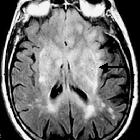primäre diffuse leptomeningeale Gliomatose (PDLG)

Long survival
of primary diffuse leptomeningeal gliomatosis following radiotherapy and temozolomide: case report and literature review. Note Gd-enhanced supra- and in-fratentorial meningeal thickenings of the brain in sagittal T1-W image (a). Prior to ra-diochemotherapy, T1-WI reveals lep-tomeningeal Gd-enhancement (b) and T2-WI shows edema of the myelon on levels C7, T1-2 and T5-6 due to minor tumor extensions in the adjacent spinal cord (c). Following radiochemotherapy, T1-WI displays reduced leptomeningeal Gd-enhancement (d) while T2-WI shows less myelon spinal edema on those levels (e).

Primary
diffuse leptomeningeal gliomatosis as a rare cause of pain in cervical spine. Diffuse T2/FLAIR hyperintensity in cerebellum, brainstem and cervical spinal cord (arrows)

Primary
diffuse leptomeningeal gliomatosis as a rare cause of pain in cervical spine. Half-body FDG-PET showing intense uptake along the brainstem, cerebellum, cervical and thoracical spinal cord (arrow)

Primary
diffuse leptomeningeal gliomatosis as a rare cause of pain in cervical spine. FDG-PET showing increased uptake in infratentorial regions, and partially on brain convexity
Als primäre diffuse leptomeningeale Gliomatose (PDLG) wird das ausschließliche bzw. primäre Auftreten einer gliösen Neoplasie im Subarachnoidalraum bezeichnet. Sie unterscheidet sich somit von einer sekundär meningealen Ausbreitung eines Glioms. Häufig ist die Hauptlokalisation spinal.
Besonders bei malignen, astrozytären Formen ist die Prognose schlecht.
Siehe auch:

 Assoziationen und Differentialdiagnosen zu primäre diffuse leptomeningeale Gliomatose (PDLG):
Assoziationen und Differentialdiagnosen zu primäre diffuse leptomeningeale Gliomatose (PDLG):






